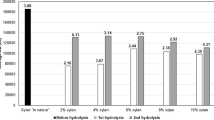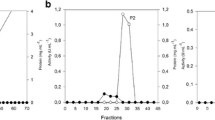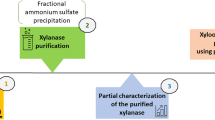Abstract
The time course of xylo-oligosaccharides concentration and xylo-oligosaccharides yield in the separation of xylo-oligosaccharides from enzymatic hydrolytes was studied using a membrane reactor with constant permeate flux of 4 L · m−2 · h−1. The results show that xylanases retain 90% of its activity in the reactor. The concentration of xylo-oligosaccharides achieves the maximum, about 5.48 g/L in 30 min. The difference of xylo-oligosaccharides in the retentate and permeate stream is low, <0.62 g/L, therefore it can permeate through membrane. Under the operating conditions that xylan concentration is 30.0 g/L, pH 5.0, operating pressure 16 kPa, temperature 48 °C, feed velocity 400 mL/min, reaction volume 400 mL, enzyme dosage 10% (volume fraction), dilution rate 1 h−1, and enzymatic hydrolysis time 195 min, the yield of xylo-oligosaccharides reaches 31.69%.
Similar content being viewed by others
References
Mcconville F X, Lopez J L, Wald S A. Biocatalysis[M]. New York: Van Nostrand Reinold, 1990.
Lopez J L, Matson S L. A multiphase/ extractive enzyme membrane reactor for production of diltiazem chiral intermediate[J]. J Membr Sci, 1997, 125(1): 189–211.
WU D R, Cramer S M, Belfort G. Kinetic resolution of racemic glycidyl butyrate using a multiphase membrane enzyme reactor[J]. Biotechnol Bioeng, 1993, 41:979–990.
Drioli E, Giorno L. Biocatalytic Membrane Reactor: Applications in the Biotechnology and the Pharmaccutical Industry[M]. London: Taylor & Francis, 1999.
Kulkarni N, Shendye A, Rao M. Molecular and biotechnological aspects of xylanases[J]. FEMS Microbiol Rev, 1999,23:411–456.
Dey D, Hinge J, Shendye A. Purification and properties of extracellular endoxylanase from an alkalophilic thermophilic Bacilus sp[J]. Can J Microbiol, 1992, 38:436–442.
George S P, Ahmad A, Rao M B. A novel thermostable xylonite from Thermonospora sp: Influence of additives on thermostability[J]. Bioresource Technol, 2001,78:221–224.
Mishra C, Keskar S, Rao M. Production and properties of extracellular xylanases from Neurospora crassa[J]. Appl Environ Microbiol, 1984,48:224–228.
Miller G L. Use of dinitrosalicylic acid reagent for determination of reducing sugar[J]. Anal Chem, 1959, 31: 426–428.
Saddler J N. Bioconversion of Forest and Agricultural Plant Residues [M]. Oxford: CAB International, 1993.
Author information
Authors and Affiliations
Additional information
Foundation item: The National Natural Science Foundation of China(No. 30070636); The Natural Science Foundation of the Education Department of Anhui Province(No. 2002kj 117)
Biography of the first author: YANG Fu-guo, doctoral student, associate professor, born in 1964, majoring in membrane separation technology.
Rights and permissions
About this article
Cite this article
Yang, Fg., Fang, Z., Xu, Y. et al. Separation of xylo-oligosaccharides from enzymatic hydrolytes using membrane reactor. J Cent. South Univ. Technol. 10, 122–125 (2003). https://doi.org/10.1007/s11771-003-0052-4
Received:
Issue Date:
DOI: https://doi.org/10.1007/s11771-003-0052-4




